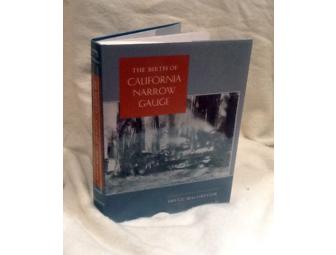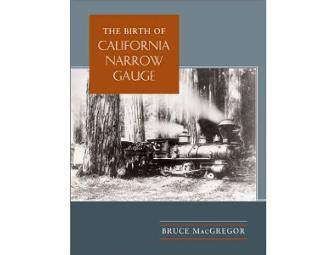Books
The Birth of California Narrow Gauge
- Item Number
- 121
- Estimated Value
- 60 USD
- Sold
- 40 USD to Live Event Bidder
- Number of Bids
- 1 - Bid History
Item Description
This long-awaited study, the magnum opus of a leading railroad historian, describes the conception, construction, and early operation of the first narrow gauge railroads in northern California. It is lavishly illustrated by some 600 photographs and drawings, almost three-quarters of which have never before been published.
The topic is approached through an unusual lens: the history of the relatively small but extraordinarily inventive contracting and engineering firm of the brothers Thomas and Martin Carter. The Carters were able to reduce the cost and complexity of light railroad construction to the point where local narrow gauge lines could initially compete with the state’s notorious railroad monopolies.
Pioneering a mobile manufacturing operation that could supply locally funded short lines with rolling stock (which traditionally came from East Coast manufacturers), the Carter Brothers began with a line to serve Salinas Valley wheat farmers, desperate to achieve an independent means for conveying their crops to the wharf in Monterey. The narrow gauge railroad that resulted was an act of political and economic defiance, but ultimately a hopeless assault on the "Octopus"—the Central Pacific and Southern Pacific Railroads.
Rallying around the example set in Monterey, a narrow gauge movement in California flourished in the mid-1870s, with the rapid launching of five more companies—the North Pacific Coast, the Santa Cruz Railroad, the Santa Cruz & Felton, the Nevada County Narrow Gauge, and the South Pacific Coast—all of which drew on the Carter Brothers for manufacturing and engineering. Soon, Thomas and Martin Carter were not only selling railroad supplies and engineering to all six short lines, but had won management positions with the strongest, the South Pacific Coast. Until personal and financial disaster overtook them in 1880, the Carters were at the forefront of not just a new business, but a new technology.
Pacific Art League stores data...
Your support matters, so Pacific Art League would like to use your information to keep in touch about things that may matter to you. If you choose to hear from Pacific Art League, we may contact you in the future about our ongoing efforts.
Your privacy is important to us, so Pacific Art League will keep your personal data secure and Pacific Art League will not use it for marketing communications which you have not agreed to receive. At any time, you may withdraw consent by emailing Privacy@frontstream.com or by contacting our Privacy Officer. Please see our Privacy Policy found here PrivacyPolicy.


